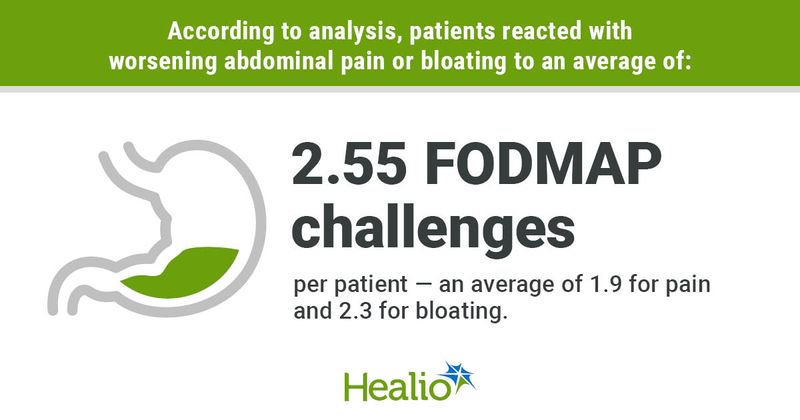Select FODMAP reintroduction worsens abdominal pain, bloating in patients with IBS
Key takeaways:
- Both fructans and galacto-oligosaccharides were linked with worsened abdominal pain upon reintroduction.
- Galacto-oligosaccharides also were associated with increase in bloating.
Reintroduction of fructans and galacto-oligosaccharides was linked to worsened abdominal pain among patients with irritable bowel syndrome who had responded to the low-FODMAP diet, according to research.
“At present, it is assumed that the clinical benefits of the low-FODMAP diet result from reductions in osmotic load and the production of fermentation byproducts derived from the exclusion of all FODMAPs,” Shanti Eswaran, MD, of the division of gastroenterology at Michigan Medicine, and colleagues wrote in Clinical Gastroenterology and Hepatology. “However, recent studies suggest that individual FODMAPs might exert different physiologic and clinical effects in different regions of the gastrointestinal tract.”

They added, “There is a pressing need to determine if exclusion of all FODMAPs is necessary to result in symptomatic improvement in patients with IBS, or if exclusion of selected groups of FODMAPs is sufficient to lead to clinical response.”
In a single-center, randomized, double-blind study, Eswaran and colleagues investigated which FODMAPs were associated with symptom generation among 45 adult patients with Rome IV criteria IBS enrolled between 2018 and 2020. Twenty-five patients demonstrated symptom improvement after a 2- to 4-week, open-label low-FODMAP elimination period and 21 patients (median age, 29.5 years; median BMI, 29.4 kg/m2; 52.4% IBS-diarrhea; 33.3% IBS-constipation) entered the 10-week blinded reintroduction phase.
Researchers noted that abdominal pain score “significantly improved” after 2 to 4 weeks on the low-FODMAP diet compared with baseline (2.8 vs. 5.8).
According to analysis, patients reacted with worsening abdominal pain or bloating to an average of 2.55 FODMAP challenges per patient — an average of 1.9 for pain and 2.3 for bloating. The fructan (P = .007) and galacto-oligosaccharide (P = .04) challenges had the strongest association with worsened abdominal pain and bloating.
While bloating also was associated with the period or time spent in the reintroduction phase (P = .002), linear mixed effects analysis showed galacto-oligosaccharides were associated with worsened bloating (P = .03) when restricted to the first reintroduction period. Other FODMAPs such as lactose, excess fructose and polyols had no “significant effects” on symptoms, researchers reported.
Overall, abdominal pain and bloating worsened throughout the study, regardless of FODMAP reintroduction (P = .006).
“We found that patients reacted to an average of two FODMAPs per patient, suggesting that most patients were not sensitive to all FODMAP subgroups,” Eswaran and colleagues wrote. “There was no significant association of individual FODMAP challenges with other gastrointestinal symptoms such as abnormal bowel habits or fecal urgency or extraintestinal symptoms such as fatigue or sleep quality.”
They continued: “Our results suggest that the reintroduction of select FODMAPs may be responsible for symptom generation in patients with IBS who have responded to a low-FODMAP diet.”

